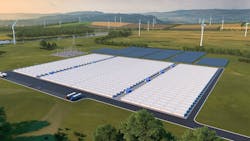Xcel Eyes Big Long-Duration Storage Investments
Xcel Energy Inc. executives are crossing their fingers a new two-site partnership with battery company Form Energy Inc. can be a blueprint for other long-duration energy storage investments.
“There's probably several 100 in our resource plans that could be realizable within the next five to 10 years if the technology proves out,” Xcel Chairman, President and CEO Bob Frenzel told analysts last week on the utility’s fourth-quarter earnings conference call.
Frenzel’s comments came after his team announced they have inked a deal with their Form Energy counterparts to deploy 10 MW/1,000 MWh iron-air battery systems at the Sherburne County and Comnache coal plants in Minnesota and Colorado, respectively, that Xcel is planning to retire. If approved by regulators, both projects are expected to come online by 2025.
Form’s technology uses the principle of “reversible rusting,” clustering iron pellets that are exposed to a stream of air to create rust and discharge energy. To charge, the oxygen is removed and the battery is fed an electrical current that converts that rust back to iron. The Form team says its systems can store electricity for 100 hours at costs comparable to legacy power plants and it is aiming to over time lower its production costs to below $20 per kWh.
Boston-based Form already has signed similar agreements with Great River Energy in Minnesota as well as Southern Co.’s Georgia Power unit. Xcel’s announcement last week noted that its analysis showed that the 100-hour iron-air batteries will help its grid handle normal weather variability as well as help during extreme weather events.
“As we go through resource plans with each of our states, we find that we have increasing need for […] dispatchable energy resources,” Frenzel said on Xcel’s call. “Historically, those would have been combustion turbines; maybe they are fired with a clean fuel like hydrogen or synthetic natural gas. Over time, as long-duration storage might become more feasible and cost-effective, you can see long-duration storage being a part of that solution.”
Form CEO and co-founder Mateo Jaramillo—who previously led Tesla’s energy storage division—and West Virginia officials in late December announced that the company had chosen a site on the Ohio River west of Pittsburgh for a $760 million battery manufacturing plant that will over time employ 750 people. Word of those plans came a few months after a list of big-name investors—TPG, ArcelorMittal and Bill Gates' Breakthrough Energy Centures among them—committed $450 million to the company’s Series E financing round.
Frenzel and his team weren’t ready last week to disclose the money they think they’ll spend on the first two Form projects, although CFO Brian Van Abel noted that, as with most new technologies, the costs will be relatively high to begin with.
“We don't see other solutions out there that are viable and it also iron oxide, right,” Van Abel added. “This is something that's readily available as we think about supply chains and what's the ability to scale.”
Shares of Xcel Energy (Ticker: XEL) closed Jan. 30 trading at $68.10, down slightly on the day. Over the past six months, they are essentially unchanged, keeping the company’s market capitalization at about $37 billion.
About the Author
Geert De Lombaerde
Senior Editor
A native of Belgium, Geert De Lombaerde has more than two decades of business journalism experience and writes about markets and economic trends for Endeavor Business Media publications T&D World, Healthcare Innovation, IndustryWeek, FleetOwner and Oil & Gas Journal. With a degree in journalism from the University of Missouri, he began his reporting career at the Business Courier in Cincinnati and later was managing editor and editor of the Nashville Business Journal. Most recently, he oversaw the online and print products of the Nashville Post and reported primarily on Middle Tennessee’s finance sector as well as many of its publicly traded companies.
